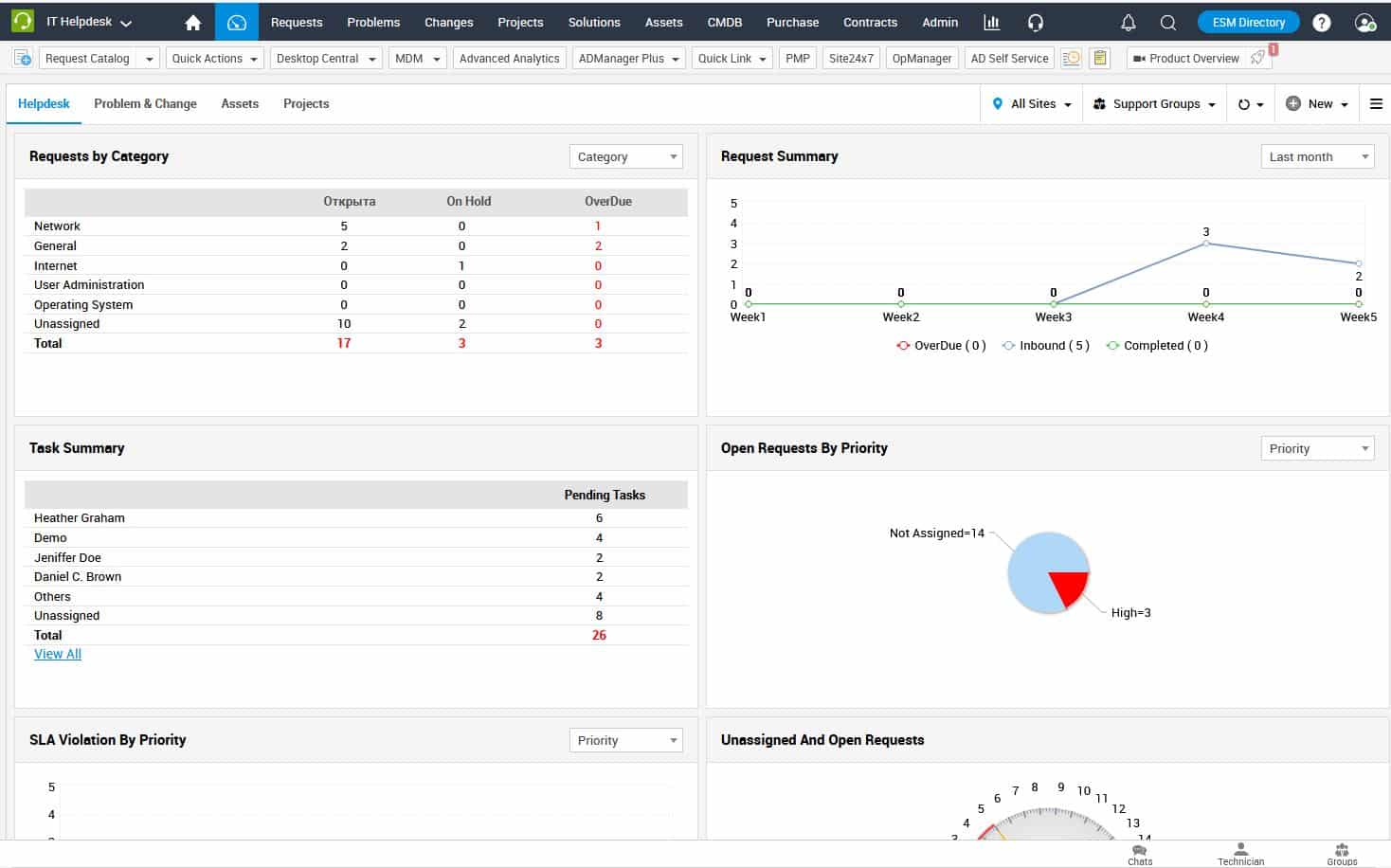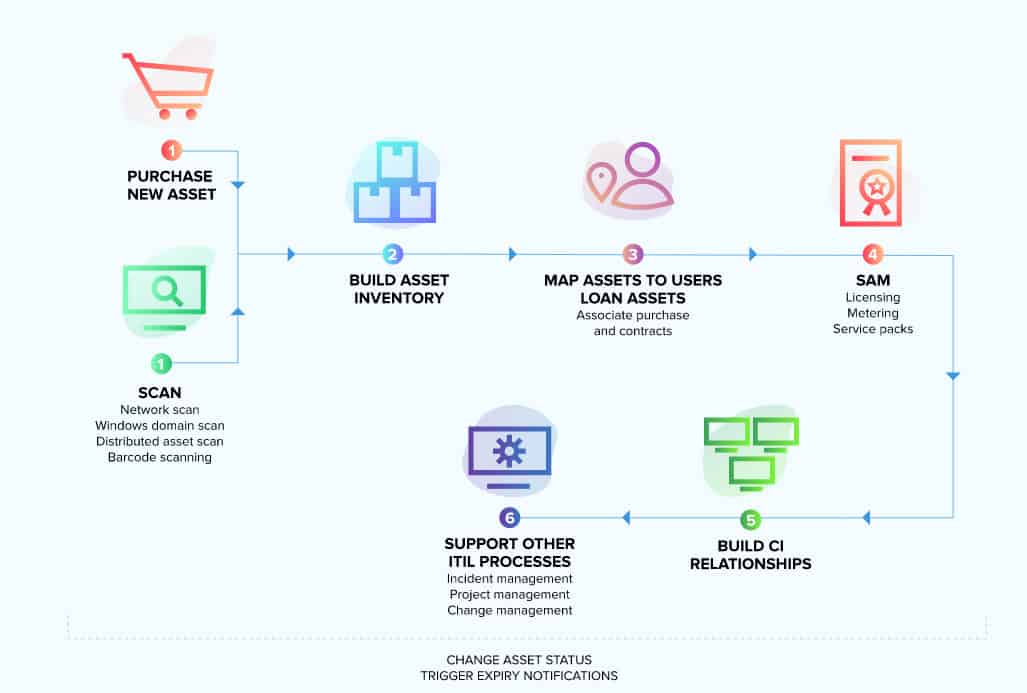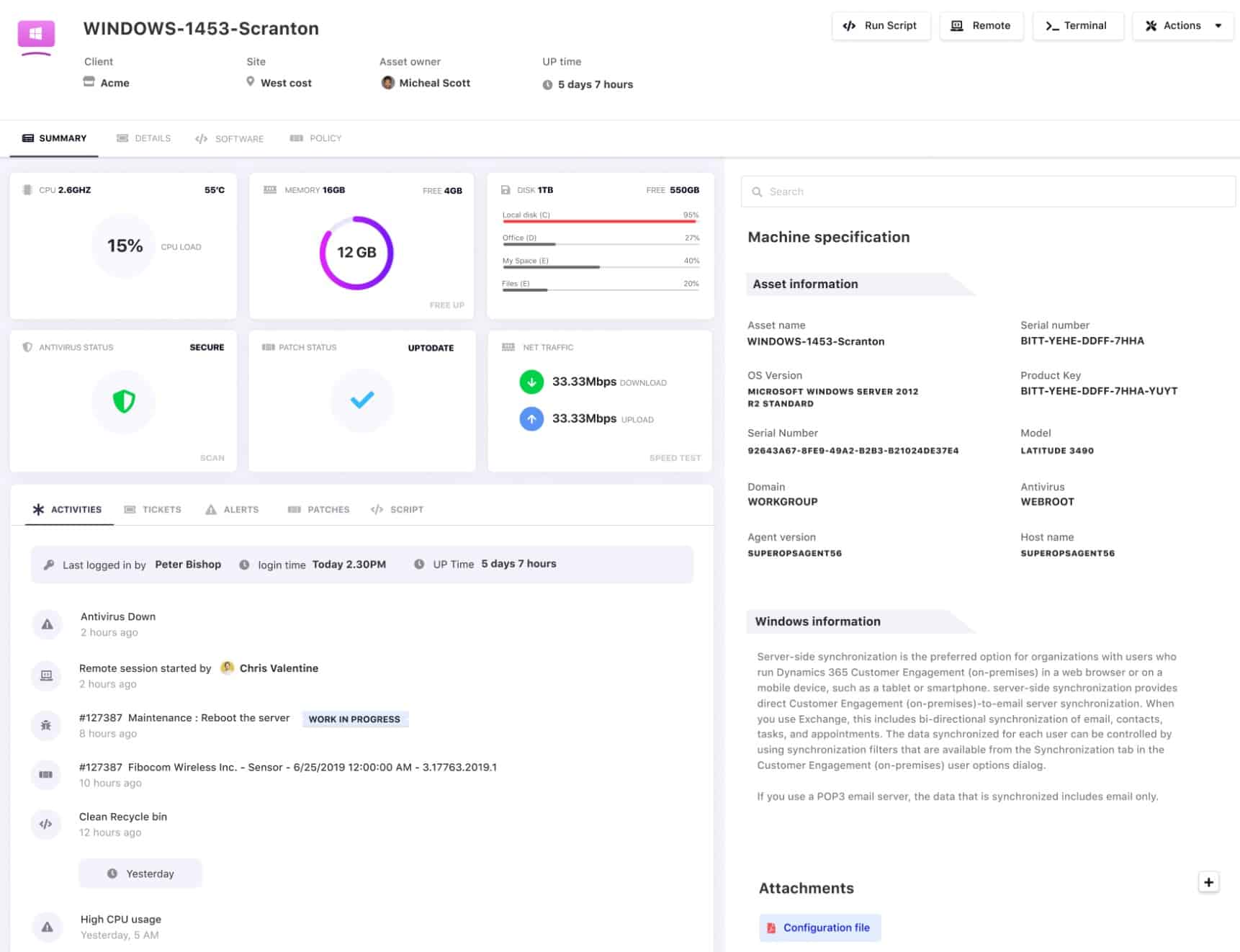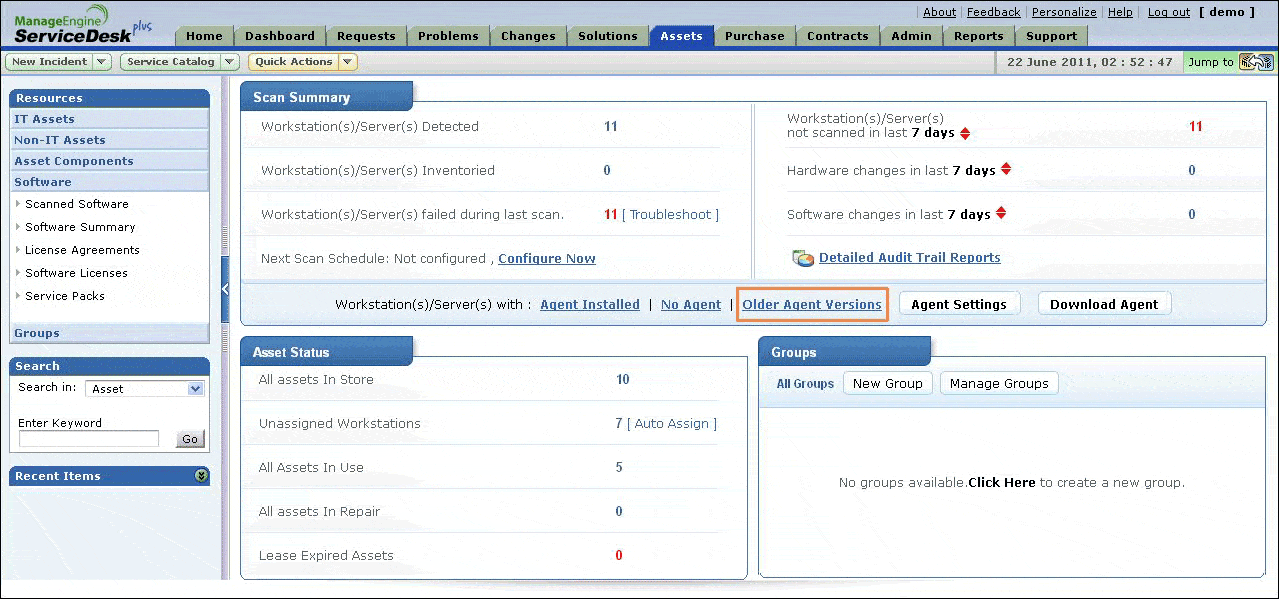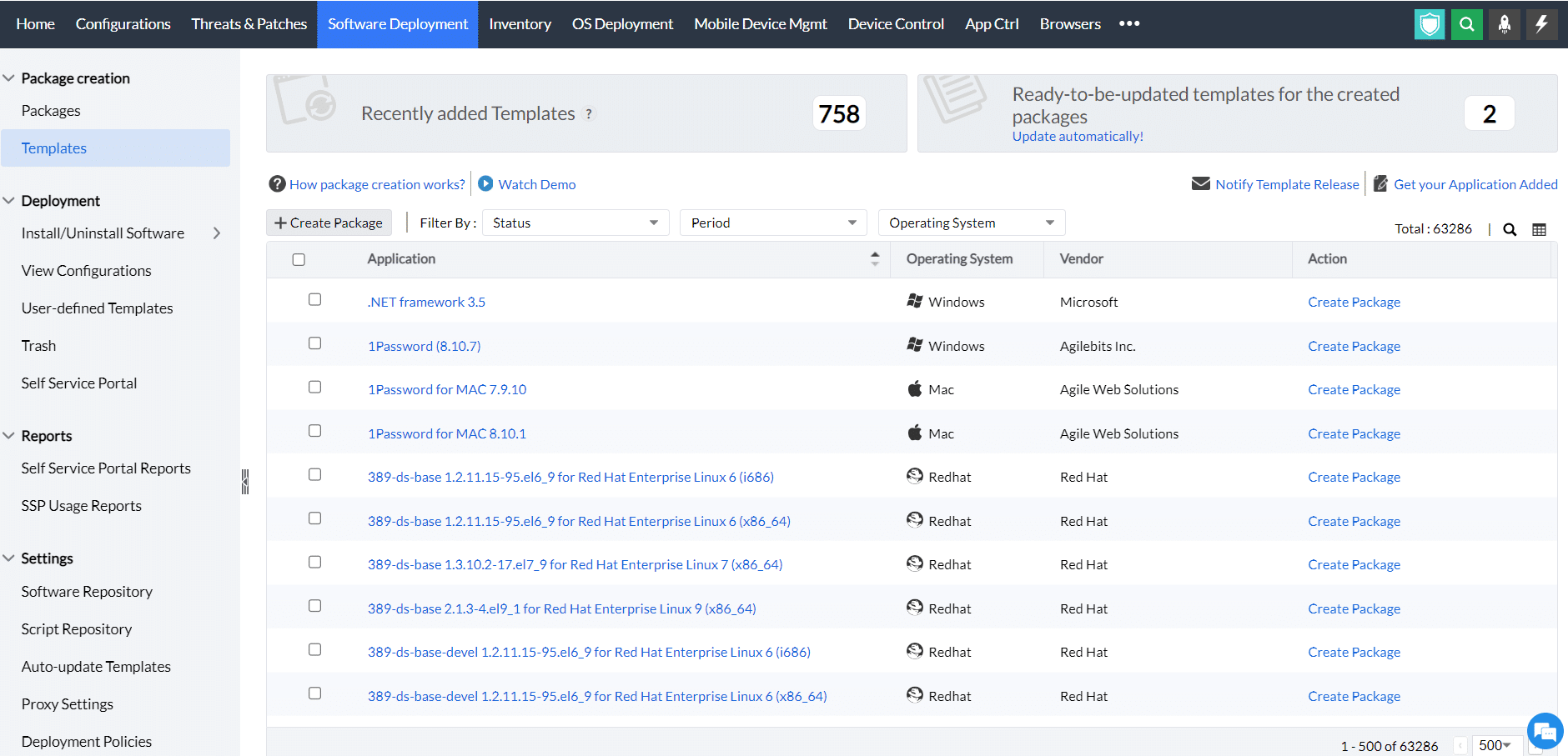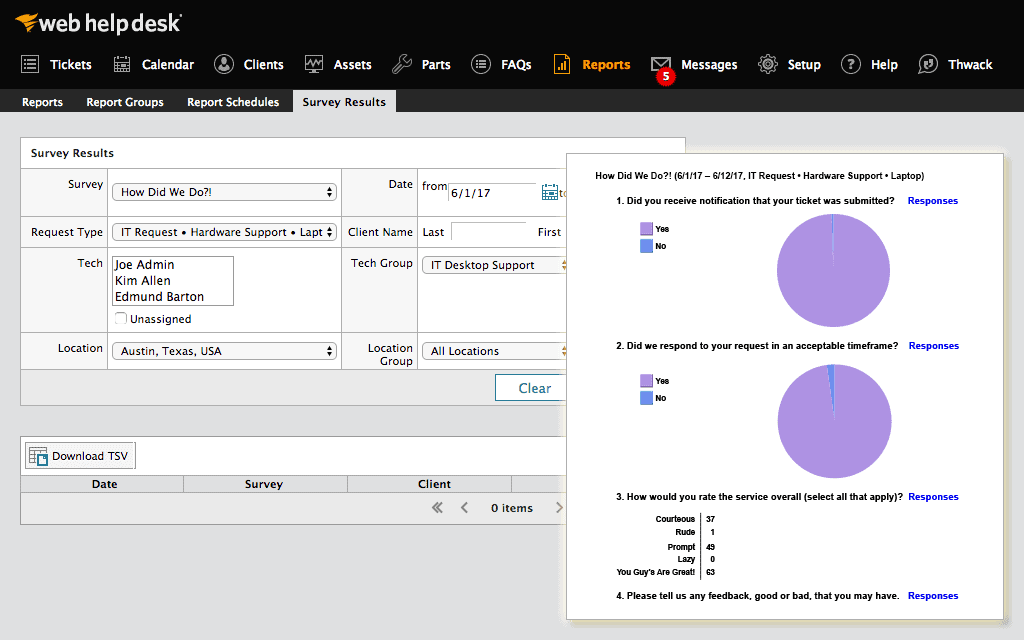We may earn a commission if you make a purchase through the links on our website.
Asset Management Software for Keeping Track of all Computers, Servers, and Devices
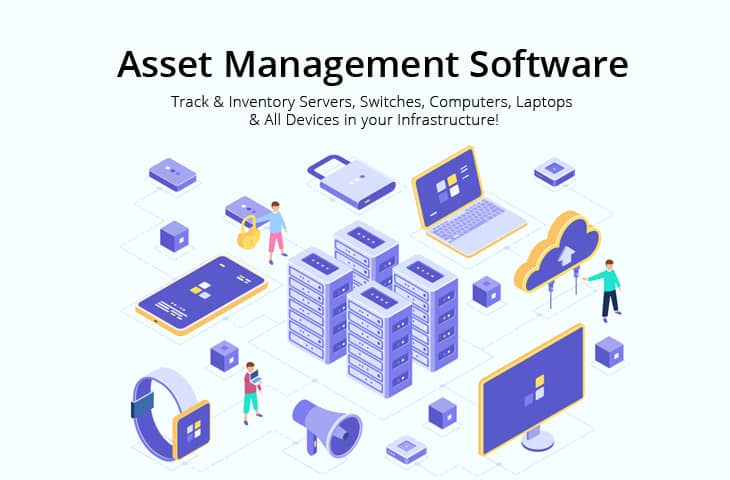
UPDATED: October 4, 2024
Businesses rely on IT for almost all aspects of their daily operations and functions. From wireless access points, workstations, mobiles, printers, to software and middleware. Maintaining control of a complex and dynamic IT environment can be quite overwhelming, and requires a particular set of skills and tools. The right IT asset management (ITAM) software can help automate tedious processes, keep track of every asset through detailed inventories, and even deal with non-IT resources like licenses, warranties, and even contracts.
Here is our list of the best IT asset management tools:
- ManageEngine ServiceDesk Plus – FREE TRIAL Built to ITIL guidelines, this package covers all aspects of ITAM, including system audits. Available as a cloud service or for installation on Windows Server or Linux. Access the 30-day free trial.
- SuperOps – FREE TRIAL This SaaS platform includes all of the tools needed to monitor and manage all assets on a remote site, including endpoints and network devices. Get 14-day free trial.
- ManageEngine AssetExplorer – FREE TRIAL Documents and tracks hardware and software and tracks service life for all assets. Installs on Windows Server. Start a 30-day free trial.
- ManageEngine Endpoint Central – FREE TRIAL This device management service includes a discovery routine that creates hardware and software inventories for asset management. Available as a SaaS platform or for installation on Windows Server. Start a 30-day free trial.
- SolarWinds Service Desk A complete Service Desk package from Help Desk system through to support team management facilities. Installs on Windows Server.
- Spiceworks IT Asset Management Part of Spiceworks Inventory, this free asset tracking tool is available as a cloud service or for on-premises installation on Windows and Windows Server.
- SecPod SanerNow Asset Management A cloud platform that provides secure software and system management tools, such as its asset management module.
- LanSweeper This tool scans, identifies, documents, and tracks hardware and software assets. Installs on Windows and Windows Server.
- Kaseya VSA Tailored to managed service providers, this package of monitoring tools traces all assets and logs them. This is a cloud-based service.
- SysAid ITSM, Service Desk, and Help Desk systems built to ITIL guidelines and offered as a cloud service.
- Network Inventory Advisor A Windows-based system that tracks down, documents, and monitors IT assets.
- Open-AudIT by FirstWave An asset discovery and tracking system that includes configuration management functions. Available for Windows Server and Linux.
Why is Asset Management Software Important?
IT Asset Management (ITAM) is a set of technologies and methodologies that help support IT asset life-cycle management and smart decision-making within an IT environment. Some of these methodologies include scanning, inventorying, license management, reporting, and more.
The ITAM software is usually designed around the idea of helping manage assets throughout all their life-cycle phases:
- Plan
- Develop/Acquire
- Deploy
- Usage
- Maintain/Upgrade
- Decommission/Retire
IT Asset Management has always been performed through lists and spreadsheets, but this becomes a near-impossible task in today's complex IT environments. ITAM software helps the IT manager automate all of these processes, so the manager can focus on improving, maximizing every resource, and reducing risks.
The software can also help maximize business expenses by identifying underutilized resources and optimizing their usage. The solution can also prevent downtime by keeping track of licenses and their End-Of-Life (EOL). Some ITAM solutions also come with automation capabilities. They can automate scans, processes, and tasks, updates, and more.
The Best IT Asset Management Software
1. ManageEngine ServiceDesk Plus with Asset Management – FREE TRIAL
ManageEngine ServiceDesk Plus gives you the option to purchase the Asset Management portion of the software that gives you the capabilities to manage, track and scan for new assets in your environment.
Key Features:
- Network Scanning: Scans networks for hardware and software to maintain an up-to-date inventory of assets.
- VM Scanning: Extend asset management capabilities to virtual machines for comprehensive coverage.
- Inventory Management: Build and manage inventory for both IT and non-IT assets, ensuring visibility and control.
- Software and Hardware Relationships: Establish and manage relationships between software and hardware components for better asset management.
- Software Compliance: Ensure compliance with software licensing agreements to avoid penalties and optimize usage.
Why do we recommend it?
ManageEngine ServiceDesk Plus with Asset Management offers a comprehensive solution for efficiently managing, tracking, and scanning assets within your environment. Our recommendation stems from its robust asset management capabilities, including the ability to scan networks for hardware and software, manage inventory, and ensure software compliance. After testing the software, we found it to be a reliable tool for streamlining asset management processes and enhancing overall IT efficiency.
Who is it recommended for?
ManageEngine ServiceDesk Plus with Asset Management is an ideal choice for organizations seeking a versatile solution for managing both IT and non-IT assets effectively. From IT departments to managed service providers (MSPs), this tool caters to diverse needs by providing automatic asset discovery, cross-platform support, and flexible deployment options. Businesses looking to streamline asset tracking, software compliance, and maintenance requests will find ServiceDesk Plus invaluable in optimizing their IT operations.
Pros:
- Comprehensive Toolset for MSPs: Provides a complete solution for managing client contracts, maintenance requests, and other ancillary services.
- Automatic Asset Discovery: Keeps NOC teams informed of scope and new devices added to the network, enhancing visibility and control.
- Cross-Platform Support: Works seamlessly with both Windows and Linux server distros, ensuring compatibility across diverse environments.
- Flexible Deployment Options: Available for on-premise deployment or as a SaaS solution, catering to different organizational preferences.
Cons:
- Learning Curve: Users may require time to explore and fully utilize the range of services and products offered by ManageEngine.
- Complexity: The extensive feature set may be overwhelming for some users, requiring careful navigation and understanding.
Start with a 30-day free trial.
2. SuperOps – FREE TRIAL
SuperOps is a cloud platform that provides remote monitoring and management (RMM) tools for managing IT assets. The system is a subscription service that is available in four plans that also provides professional services automation (PSA) system that enable managed service providers to run their businesses. These include a ticketing system that enables users to communicate problems with their equipment.
Key Features:
- RMM Package for MSPs and IT Departments: Offers a comprehensive suite of RMM tools tailored for managed service providers and IT departments.
- PSA Services for MSPs: Provides additional professional services automation functionalities to streamline business operations.
- Automated Monitoring with Alerts: Monitors IT assets and triggers alerts based on predefined performance thresholds, enabling proactive issue resolution.
- Endpoint Management: Manages hardware and software endpoints, including software license management and automated patch management.
- System Documentation Framework: Facilitates documentation of system configurations and changes, ensuring transparency and compliance.
Why do we recommend it?
SuperOps stands out as a comprehensive cloud platform offering remote monitoring and management (RMM) tools tailored for IT asset management. Our recommendation is based on its robust features, including automated monitoring with alerts, endpoint management capabilities, and a user-friendly ticketing system. Having thoroughly tested the platform, we found it to be a reliable solution for managed service providers (MSPs) and IT departments alike, offering seamless integration of RMM and professional services automation (PSA) functionalities to streamline business operations effectively.
The network device and endpoint monitoring system includes a series of performance thresholds. When one of these thresholds is tripped, the SuperOps package triggers an alert. The alerting mechanism enables automated monitoring because technicians don’t have to pay any attention to the SuperOps console unless a problem arises.
Endpoint management tools in the package include software license management and a patch manager. The patching system is able to operate unattended and it will patch the Windows and macOS operating systems as well as software packages. The system provides completion status reports.
Who is it recommended for?
SuperOps is an ideal choice for MSPs and IT departments seeking a cloud-based solution for remote monitoring and management of IT assets. With its comprehensive RMM package and additional PSA services, SuperOps caters to the needs of businesses looking to optimize their operations and enhance service delivery. Whether you're managing hardware and software inventories, automating system monitoring, or ensuring timely patch management, SuperOps provides the tools necessary to streamline workflows and improve efficiency.
Pros:
- Asset Discovery and Documentation: Simplifies asset management with comprehensive asset discovery and documentation capabilities.
- Automated System Monitoring: Proactively monitors IT assets and alerts technicians to potential issues, minimizing downtime.
- Hosted System with Storage for Metrics: Offers a hosted solution with built-in storage for metrics, ensuring scalability and reliability.
- Opportunities for Manual Performance Analysis: Provides flexibility for manual performance analysis and troubleshooting, empowering technicians to make informed decisions.
- User-Friendly Ticketing System: Facilitates communication and problem resolution with a user-friendly ticketing system, enhancing collaboration and efficiency.
Cons:
- No On-Premises Version: Lack of an on-premises version may limit deployment options for organizations with specific security or compliance requirements.
The SuperOps plans that include the RMM package are: Standard RMM-only for $99 per technician per month billed annually, Pro Unified Basic for $129 per technician per month, and Pro Unified Advance for $159 per technician per month. These rates apply to the annual payment plan for 150 endpoints. Get a 14-day free trial to assess the SuperOps SaaS platform.
3. ManageEngine AssetExplorer – FREE TRIAL
ManageEngine AssetExplorer is a web-based ITAM software that monitors and manages assets in an IT environment, and is considered one of the best for enterprise networks. It lets you manage the entire life cycle for a large number of assets, from procurement, deploy/discover, maintain, support, to retirement.
Key Features:
- Manage and Monitor IT Asset Life-Cycle: Provides comprehensive lifecycle management capabilities for IT assets, from procurement to retirement.
- Asset Discovery: Discovers assets within the network and creates detailed inventories, ensuring comprehensive asset visibility.
- Software/Hardware Monitoring: Monitors software and hardware components within the inventory, facilitating proactive management and optimization.
- Software License Compliance: Ensures compliance with software licensing agreements to avoid penalties and optimize usage.
- Configuration Management: Manages configurations to maintain consistency and standardization across IT assets.
- Purchase Order Management: Tracks purchase orders, contracts, and costs, enabling efficient procurement and expense management.
Why do we recommend it?
ManageEngine AssetExplorer stands out as a premier web-based ITAM software designed to effectively monitor and manage assets within an IT environment. Having thoroughly evaluated the platform, we find it to be an indispensable tool for enterprises seeking to streamline asset management processes and optimize expenditures through policy enforcement and asset optimization strategies. The solution provides comprehensive features, including lifecycle management, asset discovery, software/hardware monitoring, and software license compliance.
AssetExplorer comes with robust discovery mechanisms that find IT assets and create a detailed inventory from the results. The tool allows you to manage software, hardware, and licenses, within the inventory, all from a single interface. You can also manage non-IT assets and other components, such as track POs (Purchase Orders), contracts, and costs.
With the AssetExplorer, you can find areas in the organization where you can optimize expenditures, by enforcing policies or eliminating unnecessary assets.
Who is it recommended for?
ManageEngine AssetExplorer is tailored for enterprises and managed service providers (MSPs) seeking a robust solution for managing IT assets across the entire lifecycle. Ideal for large networks, AssetExplorer offers extensive capabilities for procurement, deployment, maintenance, and retirement of assets, providing unparalleled visibility and control. Whether you're looking to centralize customer management, enforce compliance, or optimize expenditures, AssetExplorer offers the tools necessary to meet your IT asset management needs effectively.
Pros:
- Dedicated ITAM Tool: Purely focuses on IT asset management without bundling additional software or features, ensuring a streamlined experience.
- Customer Data Tracking: Tracks customer data such as purchase orders, contact information, and ongoing contracts, enhancing customer relationship management.
- Free Version for Small-Scale Deployment: Offers a free version supporting up to 25 devices, making it accessible for small-scale deployments or evaluations.
- Ideal for MSPs: Great option for MSPs looking to centralize customer management and streamline service delivery processes.
Cons:
- Limited Deployment Options: Accessible via web browser but lacks cloud-based deployment, limiting flexibility for organizations preferring cloud solutions.
- Not Ideal for Bundled Solutions: May not be suitable for organizations seeking a more bundled tool with additional features beyond IT asset management.
AssetExplorer is available in three different editions:
- Free version
- Free 30-Day Fully Functional Trial
- Professional
FREE version available. For more information on pricing, request a quote. Get a fully functional 30-day free trial of ManageEngine AssetExplorer with all features.
4. ManageEngine Endpoint Central – FREE TRIAL
ManageEngine Endpoint Central is a device management package that can be upgraded into a unified endpoint management service. The bundle is intended for use by in-house IT departments for asset management. There is a version for managed service providers, called Endpoint Central MSP.
Key Features:
- Discovery Scanning: Conducts comprehensive discovery scans to identify and inventory endpoints within the network.
- Hardware and Software Inventory: Tracks hardware and software assets, providing detailed insights into device configurations and installed applications.
- Warranty Tracking: Monitors warranty information for endpoints, ensuring timely maintenance and replacement.
- Software License Management: Manages software licenses to ensure compliance and optimize usage across the organization.
- Automated Patch Management: Automates patch deployment processes, ensuring systems are up-to-date and protected against known vulnerabilities.
- Maintenance Automation Scripts: Provides pre-built scripts for automating maintenance tasks, enhancing operational efficiency.
- Remote Access Tool: Facilitates remote access to devices for both unattended and attended maintenance tasks, improving IT support capabilities.
Why do we recommend it?
ManageEngine Endpoint Central presents a comprehensive device management package that seamlessly transitions into a unified endpoint management service. ManageEngine Endpoint Central presents an invaluable asset for in-house IT departments seeking efficient asset management and maintenance automation. With its versatile capabilities and user-friendly interface, Endpoint Central streamlines device management processes and enhances overall IT efficiency.
The package tracks endpoints running Windows, macOS, and Linux and the UEM edition also manages mobile devices running Android, iOS, and ChromeOS. Software management features in the package include license management.
There is also an automated patch manager that accesses a patch availability report on the ManageEngine cloud server. If patches are available, the system copies down the installers and schedules them for installation. The bundle also includes scripts for maintenance task automation and a remote access tool.
Who is it recommended for?
ManageEngine Endpoint Central is tailored for in-house IT departments and managed service providers (MSPs) seeking a comprehensive solution for device management and endpoint security. Ideal for organizations managing diverse endpoint environments, Endpoint Central offers support for endpoints running Windows, macOS, and mobile devices running Android, iOS, and ChromeOS. Whether you're looking to streamline software license management, automate patch deployment, or facilitate remote access for device maintenance, Endpoint Central offers the tools necessary to meet your device management needs effectively.
Pros:
- Comprehensive Device Management: Offers a wide range of features for managing hardware, software, and warranties, providing comprehensive device management capabilities.
- Automated Patch Manager: Simplifies patch deployment with an automated patch manager, ensuring timely updates and enhanced security.
- Maintenance Automation Scripts: Provides pre-built scripts for automating routine maintenance tasks, reducing manual intervention and improving productivity.
- Remote Access for Device Maintenance: Facilitates remote access to devices for both unattended and attended maintenance tasks, enhancing IT support capabilities.
Cons:
- No Version for Linux: Lack of support for Linux endpoints may limit compatibility for organizations with heterogeneous endpoint environments.
ManageEngine Endpoint Central is available as a software package for Windows Server or as a SaaS platform. There are four editions:
- Professional edition – On-premises endpoint management: From $795
- Enterprise edition – On-premises device management for multiple sites: From $945
- UEM edition – All of the features of the Professional edition plus mobile device management: From $1,095
- Security edition – All of the features of the UEM edition plus security services: From $1,695
There is also a Free edition, which is the Security edition but limited to managing 25 devices. You can get a 30-day free trial of the Security edition.
5. SolarWinds Service Desk
SolarWinds Service Desk, formerly known as Samanage Service Platform, is a popular web-based ITSM and service desk for managing IT assets and employee services. The single and unified service desk solution provides a way to manage and communicate with employees in an organization through its ticketing system or self-service portal. The software also comes with powerful IT asset management (ITAM) capabilities.
Key Features:
- IT Asset Lifecycle Management: Efficiently track and manage IT assets throughout their lifecycle.
- Asset Consolidation: Consolidates all assets for streamlined management.
- License Monitoring: Monitor software licenses to ensure compliance and optimize usage.
- Manage Warranties: Easily track and manage warranties for IT assets.
- Automation: Automate repetitive tasks to increase efficiency and reduce manual effort.
Why do we recommend it?
SolarWinds Service Desk stands out as a comprehensive ITSM and service desk solution, offering robust capabilities for managing IT assets and employee services. Having extensively tested the product ourselves, we can confidently recommend it based on its seamless integration of IT asset lifecycle management, license monitoring, and automation features. With its intuitive interface and powerful functionality, SolarWinds Service Desk streamlines workflows and enhances productivity, ensuring a smooth experience for both IT professionals and end-users alike.
With SolarWinds Service Desk, you can see and manage all your assets at different stages of their lifecycle from a single place. Knowing about the life of your resources can help you avoid downtime due to EOL (End-of-Life) licenses and plan for capacity. You can also use SolarWinds Service Desk to correlate licenses to ensure you get what you buy, and even manage warranties.
You can improve your service desk or asset management solution by integrating the software with over 200 cloud applications such as NMAP, Dropbox, Azure, Jira, Okta, Slack, and more.
Who is it recommended for?
SolarWinds Service Desk is ideal for IT departments and organizations seeking a unified solution for managing IT assets and services. Small to large enterprises can benefit from its feature-rich platform, which simplifies IT asset lifecycle management, consolidates assets, and monitors licenses effectively. Additionally, businesses looking to streamline their service desk operations and improve employee communication will find SolarWinds Service Desk invaluable, thanks to its intuitive ticketing system and self-service portal.
Pros:
- User-Friendly Layout: The intuitive interface simplifies management tasks, even for large-scale operations.
- On-Premise Option: Suitable for organizations preferring on-premise solutions over cloud-based ones.
- Time Entry Tracking: Allows tracking of time entries and SLA performance for helpdesk teams.
- Proactive Alerts: Receive alerts to prevent SLA breaches and ensure timely resolution of issues.
Cons:
- Windows Server Dependency: Better suited for environments relying heavily on Windows Server.
FREE Trial available! Get a fully functional 30-day free trial of SolarWinds Service Desk and start managing all your assets.
6. Spiceworks IT Asset Management (Best Free)
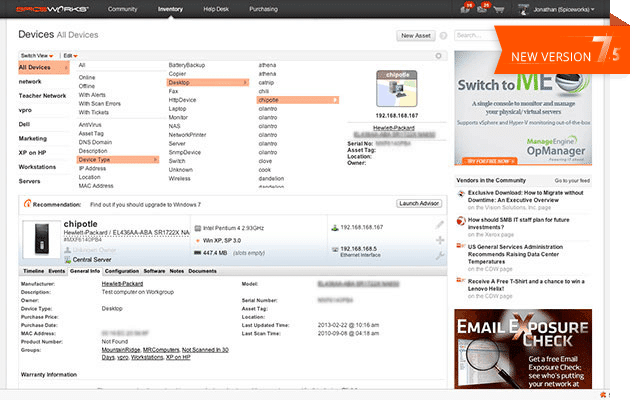
Spiceworks IT Asset Management is a free ITAM software that allows you to scan, discover, and create inventories of your IT environment. You can also obtain information from your resources and services deployed in the cloud.
Key Features:
- Inventory Hardware
- Track and update software
- Keep track of software and volume licenses
- Generate detailed reports
The functionality of the tool can be extended through integrations. You can integrate other Spiceworks tools such as the Help Desk, Network Monitoring, Connectivity Dashboard, and more.
Spiceworks starts by running automatic scans and collecting detailed information. It then creates an inventory of all your network devices, including routers, switches, VoIP phones, workstations, etc.
From this inventory, you can manage your network, including software licensing. Finally, you can create custom reports that show all the information collected by Spiceworks, from help desk tickets, the complete IT asset inventory, to network metrics.
Pros:
- Completely free cloud-based helpdesk tool
- Great functionality through the Spiceworks Help Desk Mobile App
- Easy to use interface and tools
- Great for SMB networks
Cons:
- Could use more roles and notification features to support larger deployments
Free (supported by ads). Create an account to download the free ITAM Spiceworks software here.
7. SecPod SanerNow Asset Management
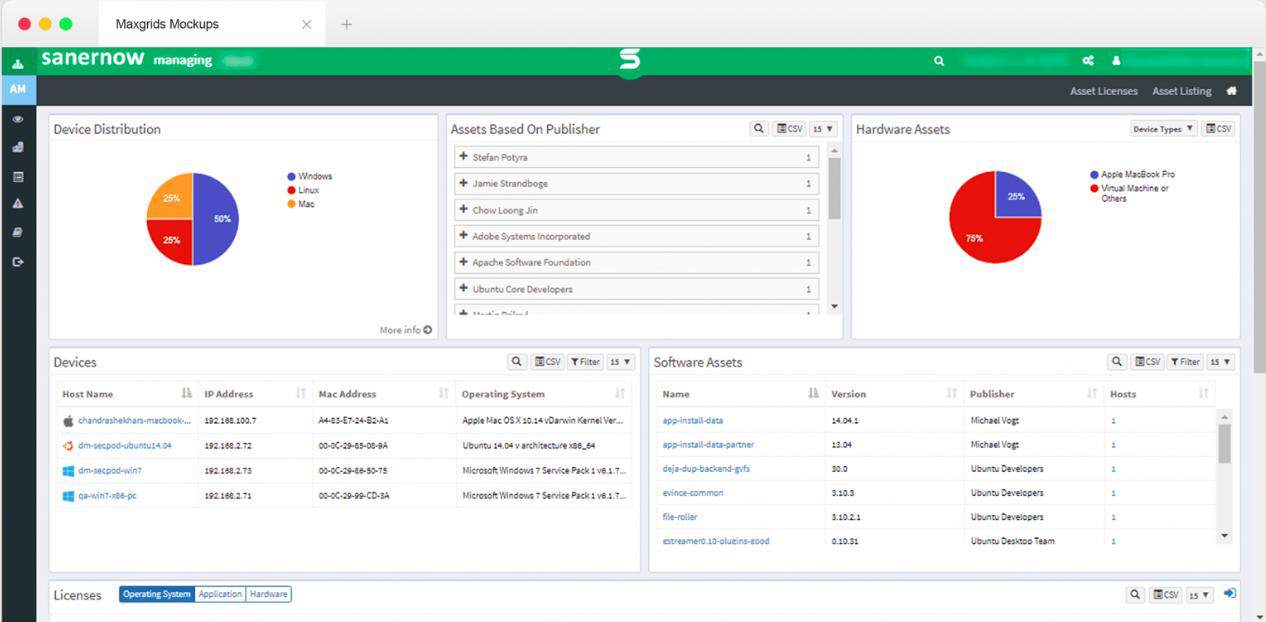
SecPod SanerNow Asset Management is a cloud-based cyber-hygiene platform that offers system management tools and security protection for endpoints. The Asset Manager module is the central repository of gathered system information and it is constantly updated.
Key Features:
- Automatically Created and Constantly Updated: Maintains a centralized repository of system information, ensuring up-to-date asset inventories and software inventories.
- Software License Usage Recording: Tracks software license usage to ensure compliance with licensing agreements and optimize software utilization.
- Constant Availability Monitoring: Documents system configurations for continuous monitoring and proactive identification of vulnerabilities.
- Cross-Platform Vulnerability Scanning: Scans devices running Windows, macOS, and Linux for vulnerabilities, providing comprehensive threat intelligence.
- Customizable Scan Frequency: Allows administrators to set vulnerability scan frequency, ensuring timely updates to asset and software inventories.
Why do we recommend it?
SecPod SanerNow Asset Management emerges as a leading cloud-based cyber-hygiene platform, offering a comprehensive suite of system management tools and security protection for endpoints. Our recommendation is rooted in its innovative approach to asset management, which combines automated asset inventorying, software license tracking, and constant availability monitoring. SecPod SanerNow offers a reliable solution for organizations seeking to enhance their cyber resilience and ensure compliance with data privacy standards through real-time vulnerability scanning and patch management.
The SecPod SanerNow Asset Management offers real-time sweeps of all your network to monitor all of its endpoints for complete visibility. This service is a vulnerability scanner that draws from a database of over 130,000 patches and firmware updates. As a basis of its actions, the scanner logs all of the endpoints that it discovers on the network and passes that information to the Asset Manager.
The Vulnerability Manager is able to scan devices running Windows, macOS, and Linux. After checking on the physical properties of each device, it examines the operating system, noting versions, and settings. All of these pieces of information get written to the Asset Inventory. The scanner then goes on to check on all of the software packages installed on each device and the results of that examination go to the Asset Manager for the creation of a Software Inventory.
The vulnerability scan frequency can be set by the administrator with a 5-minute cycle possible. Each pass updates the asset and software inventories.
Who is it recommended for?
SecPod SanerNow Asset Management is well-suited for organizations of all sizes looking to strengthen their cyber defenses and streamline asset management processes. With its cloud-based deployment model and cross-platform support for Windows, macOS, and Linux, SecPod SanerNow caters to diverse environments and IT infrastructures. Specifically, managed service providers (MSPs) stand to benefit from its automated asset tracking capabilities, making it an ideal solution for billing by the device. Whether you're concerned about vulnerability management or maintaining compliance, SecPod SanerNow offers the tools necessary to protect your network endpoints effectively.
Pros:
- Ease of Deployment: Offers ITAM capabilities through a SaaS product, simplifying deployment and maintenance compared to on-premise solutions.
- Cross-Platform Support: Supports Windows, Mac, and Linux environments, providing flexibility and compatibility across diverse IT infrastructures.
- Automated Asset Tracking: Automates asset-tracking processes, making it ideal for MSPs managing large numbers of devices.
- Hybrid Security Solution: Combines vulnerability scanning with asset management, offering a holistic approach to cybersecurity.
- Comprehensive Vulnerability Database: Draws from a database of over 130,000 patches and firmware updates, ensuring thorough vulnerability assessment and remediation.
Cons:
- Better Suited for Larger Environments: While suitable for organizations of all sizes, SecPod SanerNow Asset Management may be more cost-effective and impactful for larger environments with extensive asset management needs.
The SecPod SanerNow Asset Management package is charged for by subscription. However, SecPod doesn’t publish is price list. For more information on pricing, request a quote. Get a fully functional 30-day free trial of SanerNow to fully assess the platform.
8. Lansweeper (Best for Discovery)
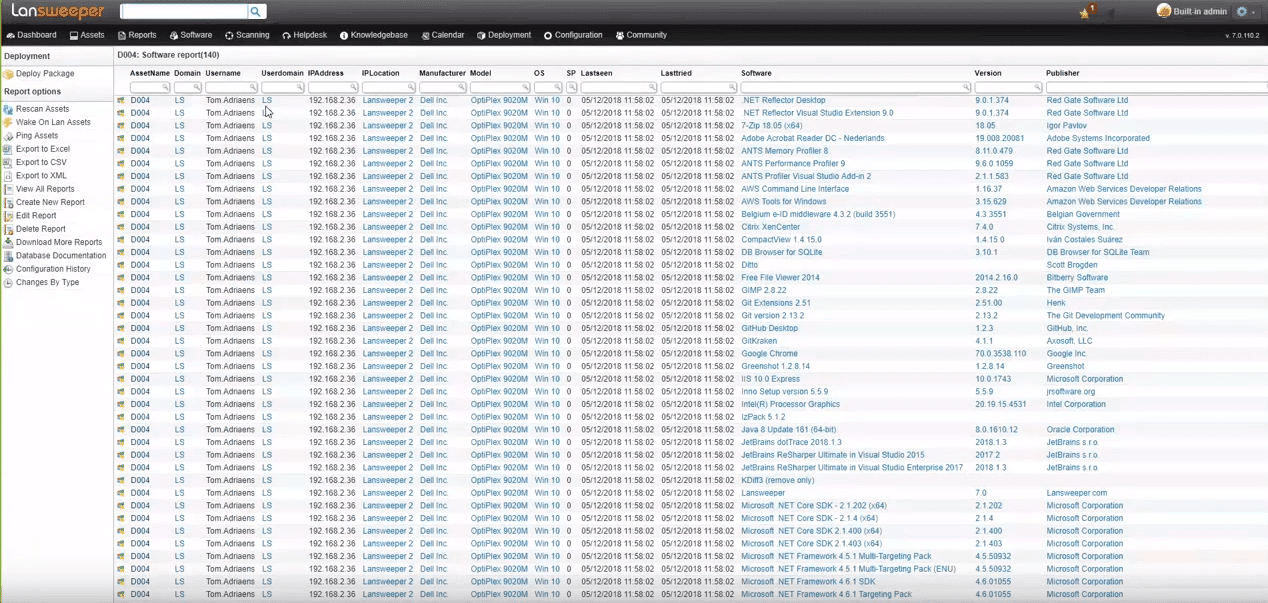
Lansweeper is a centralized IT asset management and network inventory software. It can automatically scan, discover network assets, and create detailed inventories. The software comes with an agentless discovery engine called Lansweeper Deepscan, that can find almost any IT asset in your network. It consolidates all information and creates an inventory with hardware, software, and users.
Key Features
- Powerful agent-less network discovery
- Hardware, software, and users inventory
- License audits
- Customized reports
Lansweeper can scan the software for various platforms like Linux, Windows, and macOS. It creates a software inventory, including license information. It also builds a complete hardware inventory with components, like CPU, Memory, etc. Lansweeper also helps you create reports.
You can choose from +400 templates of network reports and customize them to your needs.
Pros:
- Automatically discovers devices through customizable search filters, ideal for BYOD networks
- Recovers additional details such as hostname, manufacturer, hardware stats, and NetBIOS info
- A great option for agentless asset discovery for smaller networks
Cons:
- Only free up to 100 managed assets
- Not ideal for long-term management
Lansweeper comes in two different versions:
- Free (Up to 100 assets)
- Enterprise ($1.00 per asset/year)
Get a free fully-featured trial of Lansweeper Enterprise for 30 days.
9. Kaseya VSA (Best for MSPs)

Kaseya VSA is a cloud-based RMM (Remote Monitoring and Management) solution designed to be scalable.
Key Features:
- Hardware and software discovery
- Inventorying
- Policy-based automation
- Custom reports and dashboards
- Network Monitoring
The software is suitable for large networks like MSPs or enterprises. It provides centralized management, security services, and monitoring capabilities for all your IT assets.
Kaseya VSA is popular for its automatic patching and update deployments. The tool can update Windows, macOS, and 3rd party software.
Aside from updates, you can also manage network endpoints and its infrastructure with policy-based automation. You can automatically deploy patches or even resolve network issues.
Once installed, Kaseya VSA can automatically discover your entire network and create a comprehensive inventory. You can keep track of every single system, including their hardware and software.
Pros:
- Automated software deployments can help streamline adding new machines to the client network
- Does a good job at monitoring overall health and resource consumption of devices
- The interface is simple and customizable
- Offers a variety of MSP and multi-tenant features
Cons:
- The free trial could be longer
The price is based on the number of endpoints, for more information, request a quote. Get a fully-functional 14-day free trial of Kaseya VSA here.
10. SysAid (Best in Support)
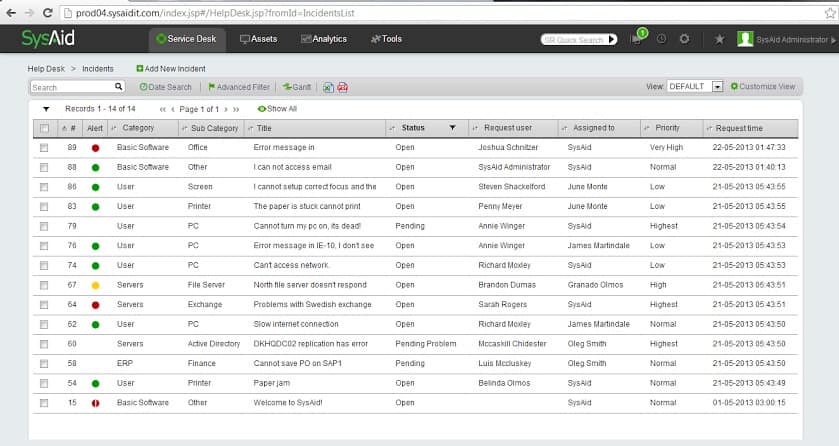
SysAid is an all-in-one cloud-based IT service management (ITSM) and help desk solution. It also includes a service desk and an integrated ITAM.
Key Features:
- Problem and change management
- Advanced workflow and automation
- Asset discovery, tracking, and inventory
- Track CIs with CMDB
- Patch and update management
- Remote control
- License management
SysAid is known for its amazing customer service and support. The solution starts with the powerful ITSM, where you can build all the other modules on top. It integrates tools like Help Desk and Asset Management into the central platform. With the ITAM solution, you can view, secure, and manage all your IT assets from a single place.
SysAid discovers all your IT assets and keeps track of them. It gathers data from the network and creates a detailed inventory with hardware and software information. You can view the software on each asset like OS and view hardware component details, like CPU, HDD, RAM, etc.
The software can also keep track of all changes made to the assets in the inventory. All changes are automatically saved as activity logs.
Pros:
- Offers SNMP monitoring through a simple plugin
- Flexible pricing options allow you to choose the features you pay for
- Good option for those looking for SNMP monitoring and patching solution
Cons:
- Lacks enterprise features – better suited for small to medium size networks
SysAid is offered in three different editions:
- Basic – Help Desk, Ticketing, and Asset Management
- Full – ITSM Software
- A-La-Carte – features priced separately
- For more information on pricing, get a quote.
Get a 30-day ITSM free trial.
11. Network Inventory Advisor (Best in Inventory)
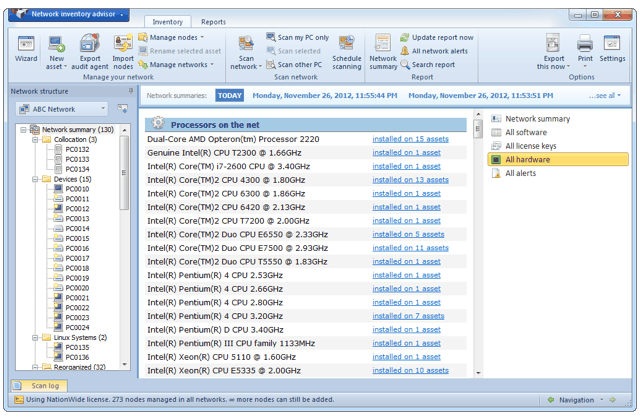
Network Inventory Advisor is a network management software that runs on Windows. It can automatically scan and collect all critical data from devices running different OSs like Windows, Linux, macOS, or any SNMP-enabled device.
The tool shows detailed hardware and software statistics. The Network Inventory Advisor is popular for its software inventorying and license tracking. You can monitor installations, software versions, services, and licenses on all computers.
You can also track non-IT assets, like keyboards or sound devices, and add them to the inventory. With this tool, you can also keep track of each hardware asset and its components such as CPU, memory, HDD, etc.
When you run the scan, the tool will collect detailed information from all your equipment and display it in the inventory.
Pros:
- Available for Mac, Linux, and Windows
- Supports SNMP for custom alert integrations
- Offers licensing management alongside security scans
Cons:
- Better suited for licensing and inventory management than security management
- The trial period could be longer
The standard license of Network Inventory Advisor for 100 nodes starts at $289.00. A fully-featured free Network Inventory Advisor is available for 15 days and you can manage up to 25 nodes.
12. OpenAudIT by FirstWave (Best in Open-Source Community)
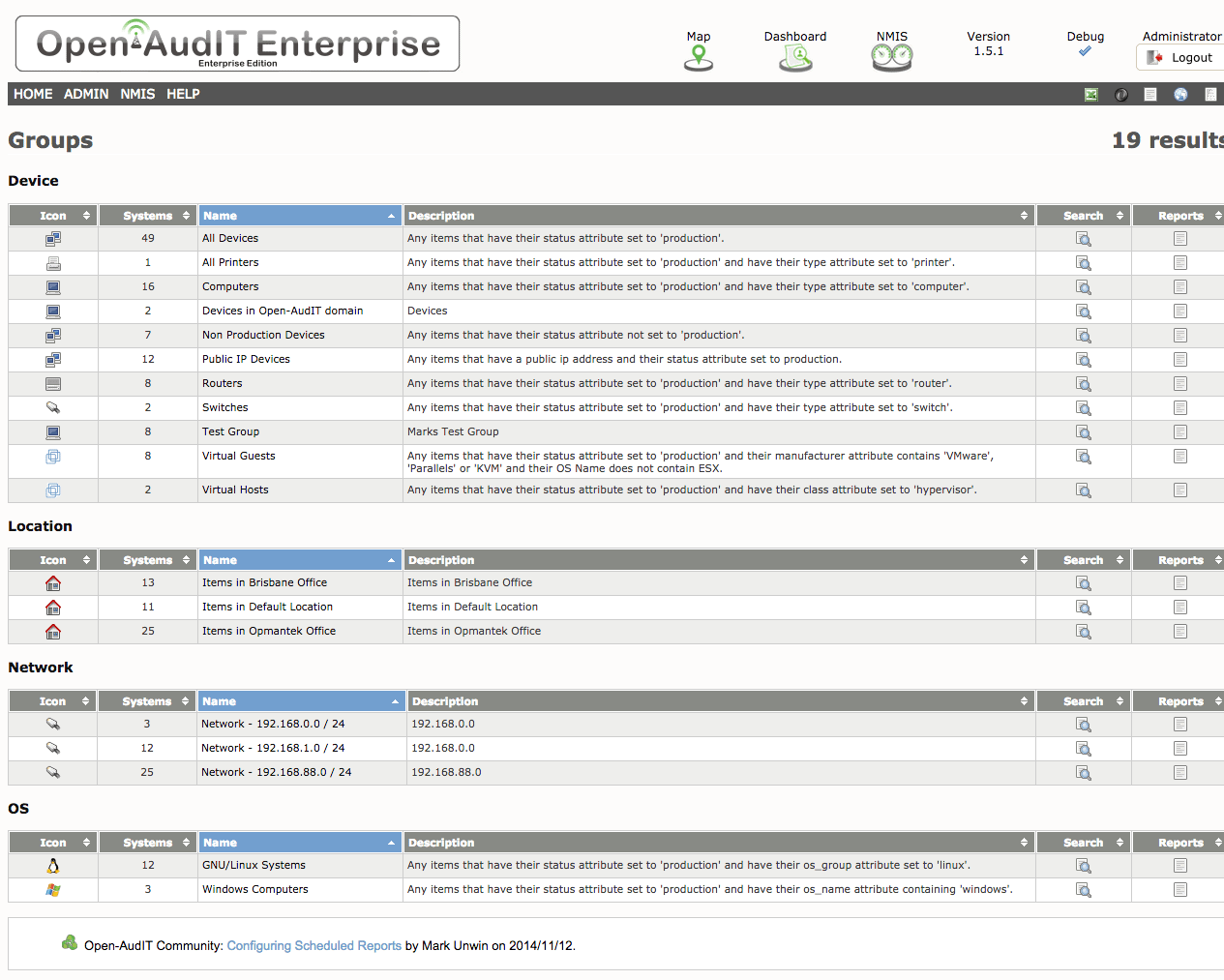
OpenAudIT is a network discovery, audit, and inventory tool that runs on Windows and Linux systems.
Key Features:
- Network device discovery
- Hardware and software inventory
- Automatic report generation
- Configuration and change tracking
- Software license management
The software can be configured to send automatic scans to the computers on a network and obtain information such as its hardware, software, settings, services, users, and more. It can also get information from network devices, such as routers and switches.
Open-AudIT can also be configured to generate automatic reports. When you set scheduled tasks, the tool will send the results of the task to your email. The output of the automatic scans containing all inventory information can also be exported through PDF, CSV, or HTML-generated webpages.
Pros:
- Completely open source and transparent project
- A simple interface is easy to use and filter through
- Supports a variety of export options (PDF, CSV, HTML)
- Better suited for smaller environments
Cons:
- Free version only includes 20 nodes
The software comes in three different editions:
- Community – Free and open-source
- Professional – starts at $1,449 per year
- Enterprise – starts at $1,199 per year
You can get a Free 20-node license for any of the Open-AudIT commercial modules here.
Final Words
IT asset management is one of the most important tasks of any IT admin, or probably the only one. But old-fashioned ITs that keep track of assets through lists, spreadsheets and old routines can hit the wall when it comes to complex IT environments.
Managing IT assets this way can be nearly impossible. The appropriate IT Asset Management (ITAM) software can help keep an inventory of the software, hardware, users, automate processes like scanning and patching, and create reports that help IT managers learn more about their IT environment.
The ITAM is directly connected to the IT infrastructure. It can keep track of all assets through their lifecycle, from planning, deploying, upgrading, to decommissioning.
The best IT asset management software for keeping track of all computers, servers, devices in your company can help those old-fashioned IT admins get rid of the spreadsheet.
ManageEngine AssetExplorer is a great tool to begin with, and the best of all, they offer a free trial.
